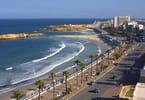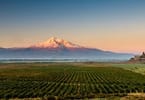TOKYO — Ten years after serious volcanic activity began on Mount Oyama, located on Miyakejima island in the Izu island chain, residents are trying to utilize the island’s dynamic landscape — sculpted by 13 eruptions over 500 years — to attract tourists and revitalize the community.
Volcanic activity has mostly waned since beginning in earnest on June 26, 2000, and residents began returning five years ago. However, emissions of volcanic gas continue, and damage caused by eruptions can still be seen in parts of the landscape.
In Miyakemura village, steel bars from a ruined building stand high, and part of a car buried in volcanic ash can be seen underfoot.
According to the Meteorological Agency, the amount of harmful sulfur dioxide in the volcanic gas being emitted has fallen from more than 50,000 tons a day in 2000 to about 1,000 tons last year.
Level 4 warnings, which indicate a threat of serious harm to healthy people, have not been issued since April 2009.
“The amount is on the same level as emissions from Sakurajima island and Mount Aso. It will likely continue declining,” said Toshitsugu Fujii, chairman of the Coordinating Committee for Prediction of Volcanic Eruptions.
About 80,000 tourists visited the island in 1999, before the eruptions, but there were only about 38,000 last year. Many Miyakejima residents became unable to earn a living, and thus the island’s population has leveled out at about 2,800, about 70 percent of its number before the eruptions.
To break the feeling of helplessness, the entire village has started promoting “volcanic tourism.” For example, the village government last year named unique places created by lava flows on the island “geo spots” and set up explanatory signs at eight sites, including a shrine’s torii gate and buildings of primary and middle schools that were buried by pyroclastic and lava flows.
Residents have organized tours of volcanic sites since February and drawn more than 50 off-island tourists to the former pastureland.
Such attempts have increased the number of tourists to the island. “We want to use the unusual scenery of this volcanic island to bring more tourists and restore the village’s former vigor,” said Hiroyuki Noda, 47, the owner of an inn who planned a tour of volcanic sites.
Miyakejima is a volcanic island with an area of about 55.5 square kilometers. It is located about 180 kilometers south of central Tokyo.
Mount Oyama has erupted almost every 20 years since 1940. After the 2000 eruption, all island residents were ordered to evacuate from September 2000 until February 2005.
Volcanic ash and gas killed 60 percent of the island’s forests, mainly on the upper side of Mount Oyama, and caused other damage as well.
WHAT TO TAKE AWAY FROM THIS ARTICLE:
- “We want to use the unusual scenery of this volcanic island to bring more tourists and restore the village’s former vigor,” said Hiroyuki Noda, 47, the owner of an inn who planned a tour of volcanic sites.
- According to the Meteorological Agency, the amount of harmful sulfur dioxide in the volcanic gas being emitted has fallen from more than 50,000 tons a day in 2000 to about 1,000 tons last year.
- TOKYO — Ten years after serious volcanic activity began on Mount Oyama, located on Miyakejima island in the Izu island chain, residents are trying to utilize the island’s dynamic landscape — sculpted by 13 eruptions over 500 years — to attract tourists and revitalize the community.






















